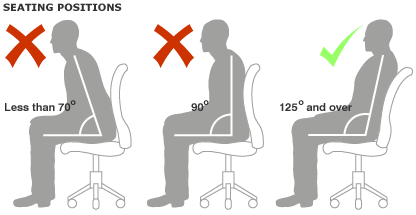
Click the picture to be directed to the article accompanying it (or click the Comments link below). Thanks to Caroline Ross for sending me the link, and to Heather Atchison for being involved in the research. Notice that the leaning back posture has a perfectly vertical lower spine, a fact that seems to have passed the journalist who wrote the article by.
2 comments
It comes from Heather's department, but we forgot to ask her this evening if she was in fact involved in the research... Davina actually found this article this morning. As you mention, it is already being misinterpreted as 'slouching is good for you', particularly in the Times, today.
This is the text of the article:
Sitting up straight is not the best position for office workers, a study has suggested.
Scottish and Canadian researchers used a new form of magnetic resonance imaging (MRI) to show it places an unnecessary strain on your back.
They told the Radiological Society of North America that the best position in which to sit at your desk is leaning slightly back, at about 135 degrees.
Experts said sitting was known to contribute to lower back pain.
Data from the British Chiropractic Association says 32% of the population spends more than 10 hours a day seated.
Half do not leave their desks, even to have lunch.
Two thirds of people also sit down at home when they get home from work.
Spinal angles
The research was carried out at Woodend Hospital in Aberdeen, Scotland.
Twenty two volunteers with healthy backs were scanned using a positional MRI machine, which allows patients the freedom to move - so they can sit or stand - during the tests.
Traditional scanners mean patients have to lie flat, which may mask causes of pain that stem from different movements or postures.
In this study, the patients assumed three different sitting positions: a slouching position, in which the body is hunched forward as if they were leaning over a desk or a video game console, an upright 90-degree sitting position; and a "relaxed" position where they leaned back at 135 degrees while their feet remained on the floor.
The researchers then took measurements of spinal angles and spinal disk height and movement across the different positions.
Spinal disk movement occurs when weight-bearing strain is placed on the spine, causing the disk to move out of place.
Disk movement was found to be most pronounced with a 90-degree upright sitting posture.
It was least pronounced with the 135-degree posture, suggesting less strain is placed on the spinal disks and associated muscles and tendons in a more relaxed sitting position.
The "slouch" position revealed a reduction in spinal disk height, signifying a high rate of wear and tear on the lowest two spinal levels.
When they looked at all test results, the researchers said the 135-degree position was the best for backs, and say this is how people should sit.
'Tendency to slide'
Dr Waseem Bashir of the Department of Radiology and Diagnostic Imaging at the University of Alberta Hospital, Canada, who led the study, said: "Sitting in a sound anatomic position is essential, since the strain put on the spine and its associated ligaments over time can lead to pain, deformity and chronic illness."
Rishi Loatey of the British Chiropractic Association said: "One in three people suffer from lower back pain and to sit for long periods of time certainly contributes to this, as our bodies are not designed to be so sedentary."
Levent Caglar from the charity BackCare, added: "In general, opening up the angle between the trunk and the thighs in a seated posture is a good idea and it will improve the shape of the spine, making it more like the natural S-shape in a standing posture.
"As to what is the best angle between thigh and torso when seated, reclining at 135 degrees can make sitting more difficult as there is a tendency to slide off the seat: 120 degrees or less may be better."
Post a Comment